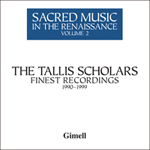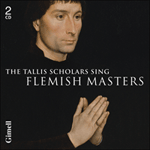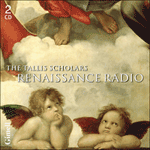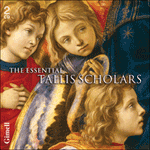
Welcome to Hyperion Records, an independent British classical label devoted to presenting high-quality recordings of music of all styles and from all periods from the twelfth century to the twenty-first.
Hyperion offers both CDs, and downloads in a number of formats. The site is also available in several languages.
Please use the dropdown buttons to set your preferred options, or use the checkbox to accept the defaults.

However, the influence of these slow-moving notes can be heard throughout the work, whether they are actually there or not, in the solid, slow-changing underlying chords. A casual listener to the Missa Et ecce terrae motus, confused at first by the teeming detail of the rhythmic patterns, may hear only some rather disappointing harmonies. Closer listening will reveal why Brumel chose to write in so many parts: he needed them to decorate his colossal harmonic pillars. In doing so he effectively abandoned polyphony in the sense of independent yet interrelated melodic lines, and resorted to sequences and figurations which were atypical of his time. The effect can even be akin to that of Islamic art: static, non-representational, tirelessly inventive in its use of abstract designs, which are intensified by their repetitive application. This style of writing is so effective that anyone who might be reminded of Tallis’s Spem in alium would be unable to conceive of the need for another twenty-eight parts.
The manuscript source for Brumel’s ‘Earthquake’ Mass (Munich Bayerische Staatsbibliothek Mus.MS1) was copied for a performance in about 1570 at the Bavarian court. The names of the thirty-three court singers are given against the nine lower parts (the boys are not named), amongst whom Lassus sang Tenor II. Unfortunately the last folios, which contain the Agnus Dei, have rotted, leaving holes in the voice-parts. Any editor of the piece is presented with the unusual task of trying to guess where the notes which he can read might fit, as they are placed on the page in individual parts rather than in score; then re-compose what is missing. This was done for Gimell by Francis Knights. A further Agnus Dei, on the Et ecce terrae motus chant and attributed to Brumel, survives in Copenhagen; but it is widely thought not to belong to the twelve-part Mass, since it is for six voices, which use different vocal ranges from those in the twelve-part setting. In addition its musical style differs in various important respects from that of the larger work, not least in quoting many more than the first seven notes of the chant. For these reasons it has been omitted here. The Mass is scored for three sopranos, one true alto, five wide-ranging tenors and three basses. The tessitura of all these parts (except perhaps that of the sopranos) is unpredictable to the point of eccentricity. Countertenor II, for example, has a range of two octaves and a tone, the widest vocal range I have ever met in renaissance music.
from notes by Thomas Phillips © 1992
Cependant, qu’elles soient présentes ou non, ces notes lentes font entendre leur influence tout au long de l’oeuvre, dans les accords qui en sont à la base et qui changent peu à peu. Un auditeur peu vigilant de la Missa Et ecce terrae motus, tout d’abord dérouté par les motifs rythmiques si grouillants de détails, n’entendra peut-être que quelques harmonies plutôt décevantes. Une écoute plus attentive montre bien pourquoi Brumel choisit d’écrire pour un tel nombre de voix: elles lui étaient nécessaires pour orner ses immenses piliers harmoniques. Ainsi, il abandonna réellement la polyphonie au sens de lignes mélodiques indépendantes mais reliées, et eut recours à des séquences et des ‘figures’ qui n’étaient pas typiques de l’époque. On peut même rapprocher cet effet de celui de l’art islamique: statique, non-figuratif, constamment inventif dans son emploi de motifs abstraits que renforce leur usage répété. Ce style d’écriture est si efficace que quiconque ayant en mémoire le Spem in alium de Tallis ne pourrait concevoir le besoin de vingt-huit autres voix.
Le manuscrit d’origine de la Messe ‘Tremblement de terre’ de Brumel (Munich Bayerische Staatsbibliothek Mus.MS1) fut copié pour que l’oeuvre fût donnée à la cour de Bavière vers 1570. Les noms des trente-trois chanteurs de la cour figurent devant les neuf voix les plus basses (les enfants ne sont pas nommés), dont Lassus, qui tenait la place de tenor II. Malheureusement, les derniers feuillets, où se trouve l’Agnus Dei, ont souffert de l’humidité, laissant des parties incomplètes. Tout éditeur de cette oeuvre est confronté à une tâche inhabituelle: il doit tenter d’imaginer la place des notes qui sont lisibles, car elles sont disposées sur la page séparément plutôt qu’en partition, puis de reconstituer ce qui manque. Francis Knights a fait ce travail pour Gimell. Il reste à Copenhague un autre Agnus Dei attribué à Brumel, sur le plain-chant de Et ecce terrae motus, mais on considère généralement qu’il ne fait pas partie de la Messe à douze voix, dans la mesure où il est écrit pour six voix dont les registres sont différents de ceux employés dans l’oeuvre à douze voix. De plus, sur nombre de points importants, son style musical diffère de celui de l’oeuvre plus étoffée, en particulier – et ce n’est pas la moindre différence – en citant beaucoup plus de notes que les sept premières du plain-chant. La Messe est écrite pour trois parties de superius (soprano), une d’altus, cinq de tenor d’un registre étendu et trois de bassus. La tessiture de toutes ces voix (sauf peut-être celle des sopranos) est imprévisible, voire excentrique. Par exemple, le contratenor II couvre deux octaves et un ton, ce qui représente le registre vocal le plus étendu que j’aie jamais rencontré dans la musique renaissante.
extrait des notes rédigées par Peter Phillips © 1992
Français: Meena Wallaby
Aber diese breit fortschreitende Melodie beeinflußt hörbar den Verlauf des ganzen Werkes, ob sie nun konkret greifbar ist oder nicht, und zwar in Gestalt der festgefügten, nur langsam wechselnden, stützenden Akkorde. Bei flüchtigem Hören der Messe Et ecce terrae motus ist man wahrscheinlich verwirrt von der Vielfalt der rhythmischen Muster und möglicherweise auch etwas enttäuscht von der harmonischen Struktur. Erst bei intensivem Zuhören beantwortet sich die Frage, warum sich Brumel bei der Komposition für die Verwendung von gleich zwölf Stimmen entschieden hat: er benötigte sie zum klanglichen Füllen der harmonischen Stützpfeiler. Zu deren Gunsten ließ er in der Tat die Polyphonie im Sinne einer Ebenbürtigkeit der einzelnen Stimmen zurücktreten und beschränkte sich auf sequenzartige Wendungen und Floskeln, wie sie eigentlich für seine Zeit nicht charakteristisch sind. Die Wirkung dieser Konzeption erinnert sogar an ähnliche Verfahren der islamischen Kunst: statisch und unbildhaft in ihrer Darstellung, unermüdlich einfallsreich in ihren abstrakten Formgebungen, die durch die ständige Wiederholung noch an Intensität gewinnen. Diese Kompositionsweise erweist sich als dermaßen überzeugend, daß man sich im Hinblick auf Tallis’ Spem in alium hier keine weiteren 28 Stimmen mehr vorzustellen braucht.
Die hier verwendete handschriftliche Quelle der Messe Brumels aus der Bayerischen Staatsbibliothek in München (Mus.Ms.1) wurde für eine Aufführung am Bayerischen Hof um 1570 erstellt. Die Namen der 33 Hofsänger sind in den neun Stimmen der tieferen Lagen angegeben (die hohen Knabenstimmen werden nicht erwähnt), unter ihnen befand sich als Tenor II Orlando di Lasso. Bedauerlicherweise sind die letzten Seiten, die das Agnus Dei enthalten, beschädigt, so daß bestimmte Stellen fehlen. Will man nun eine Edition erstellen, so wird man mit der ungewöhnlichen Aufgabe konfrontiert, die einzelnen Stimmen und Noten einander zuzuordnen, da ja keine Partitur vorliegt, sondern nur ein Chorbuch, in dem die Stimmen einzeln auf Doppelseiten notiert sind. Die fehlenden Stellen müssen nachkomponiert werden. Francis Knights hat diese Aufgabe für Gimell übernommen. Brumel wird noch ein weiteres Agnus Dei mit der gregorianischen Et ecce terrae motus-Melodie als Cantus firmus zugeschrieben, das sich in Kopenhagen befindet; jedoch wird weithin angenommen, daß es nicht zu unserer Messe gehört; es ist sechsstimmig und unterscheidet sich im Ambitus der Stimmen von dem der zwölfstimmigen Messe. Darüberhinaus weist die musikalische Faktur grundlegende Unterschiede gegenüber dem größeren Werk auf; nicht zuletzt wird der Cantus firmus in weit größerem Ausmaß als nur mit den ersten sieben Tönen verarbeitet. Die Messe fordert eine Besetzung von drei Sopranen, einer echten Altstimme, fünf Tenören mit großem Stimmumfang und drei Bässen. Der extrem ausgedehnte Bereich, in dem sich die Stimmen (vielleicht mit Ausnahme der Soprane) bewegen, grenzt ans Kuriose. So wird beispielsweise für den Contratenor II ein Stimmumfang von zwei Oktaven und einem Ton erwartet; mehr ist mir innerhalb der Vokalmusik der Renaissance nicht begegnet.
aus dem Begleittext von Peter Phillips © 1992
Deutsch: Gerd Hüttenhofer
 Sacred Music in the Renaissance, Vol. 2 Sacred Music in the Renaissance, Vol. 2The second of three volumes featuring The Tallis Scholars' finest recordings, one for each decade, and each offering over five hours of the award-winning performances that helped establish Renaissance Polyphony as one of the great repertoires of w ...» More |
 The Tallis Scholars sing Flemish Masters The Tallis Scholars sing Flemish Masters"The Flemish masters have been at the heart of our work from the beginning, just as they were at the heart of the whole Renaissance musical scene—and their Masses were the showcase in which they displayed their most sophisticated achievements. Thi ...» More |
 Renaissance Radio Renaissance RadioSacred Music from the Renaissance Era for Celestial and Secular Radio. When Peter Phillips founded The Tallis Scholars in 1973 sacred vocal music from the Renaissance Era was seldom heard on radio. Now it is firmly established as one of the great ...» More |
 The Essential Tallis Scholars The Essential Tallis Scholars"I am delighted to recommend this selection from our recordings. It is an excellent introduction to our work and to Renaissance music in general." (Peter Phillips)» More |

